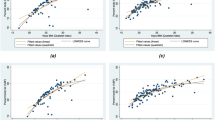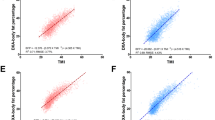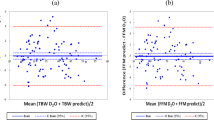Abstract
OBJECTIVE: Due to the fact that obesity is defined as excess of body fat mass, we tested the hypothesis whether the body mass index (BMI) can be used as a valid measure for the detection of the degree of obesity in individual obese children and adolescents.
METHODS: A total of 204 obese children and adolescents (105 boys, 99 girls) aged 6–17 y, using total body electrical conductivity (TOBEC) for fat measurement, were included into this study.
A multiple regression analysis was performed with percentage body fat (PBF) as dependent variable and BMI, age and sex as independent variables. First- and second-order interaction terms were also included. Since all interaction terms showed a significant influence on PBF, regression analysis was performed separately for boys and girls, dividing each group into two age subgroups (subjects younger than 10 y, and subjects 10 y or older).
RESULTS: BMI and PBF were observed to be positively correlated (overall: r=0,65; P=0.0001; boys r=0.63 and girls: r=0.68). Through a multiple regression analysis 57% of the variance of PBF could be explained by the independent variables. In boys younger than 10 y 73% and in girls younger than 10 y 63% of the variance of PBF was explained by the BMI. In subjects 10 y or older the association was poor (boys: 27%; girls: 38%). It should be emphasized that there is a wide range in the relationship between PBF and BMI in the obese subjects.
CONCLUSION: From these results we conclude that BMI might be a useful parameter for epidemiological studies: however in the individual pediatric patient, especially from 10 y onwards, it gives only a limited insight to the degree of obesity based on the definition.
This is a preview of subscription content, access via your institution
Access options
Subscribe to this journal
Receive 12 print issues and online access
$259.00 per year
only $21.58 per issue
Buy this article
- Purchase on Springer Link
- Instant access to full article PDF
Prices may be subject to local taxes which are calculated during checkout





Similar content being viewed by others
References
Troiano RP, Flegal KM, Kuczmarski RJ, Campbell SM, Johnson CL . Overweight prevalence and trends for children and adolescents Arch Pediatr Adolesc Med 1995 149: 1085–1091.
Barth N, Ziegler A, Himmelmann GW, Coners H, Wabitsch M, Henninghausen K, Mayer H, Remschmidt H, Schärfer H, Hebe-brand J . Significant weight gains in clinical sample of obese children and adolescents between 1985 and 1995 Int J Obes Relat Metab Disord 1997 21: 122–126.
DiPietro L, Mossberg H-O, Stunkard AJ . A 40-year history of overweight children in Stockhom: life-time overweight, morbidity, and mortality Int J Obes Relat Metab Disord 1994 18: 585–590.
Kaufer Christoffele K, Ariza A . Commentary: The epidemiology of overweight in children: relevance for clinical care Pediatrics 1998 101: 103–105.
Vanltallie TB . Predicting obesity in children Nutr Rev 1998 56: 154–155.
Guo SS, Roche AF, Chumela WC, Gardener JD, Siervogel RM . The predictive value of childhood body mass index values for overweight at age 35 y Am J Clin Nutr 1994 59: 810–819.
Troiano RP, Frongillo EA Jr, Sobal J, Levitsky DA . The relationship between body weight and mortality: a quantitative analysis of combined information from existing studies Int J Obes Relat Metab Discord 1996 20: 63–75.
Power C, Lake JK, Cole TJ . Measurement and long-term health risks of child and adolescent fatness Int J Obes Relat Metab Disord 1997 21: 507–526.
Poskitt EME . Defining childhood obesity: the relative body mass index (BMI) Acta pediatr 1995 84: 961–963.
Wolff OH, Lloyd JK . Obesity Medicine 1974 27: 1583.
Marshall JD, Hazlett CB, Spady DW, Conger PR, Quinney HA . Validity of convenient indicators of obesity Hum Biol 1991 63: 137–153.
Hannan WJ, Wrate RM, Cowen SJ, Freeman CP . Body mass index as an estimate of body fat Int J Eat Disord 1995 18: 91–97.
Rolland-Cachera M-F, Cole TJ, Sempé M, Tichet J, Rossignol C, Charrand A . Body mass index variations: centiles from birth to 87 y Eur J Clin Nutr 1991 45: 13–21.
Puig M . Body composition and growth. In: Walker and Walkins (eds) Nutrition in Pediatrics, 2nd edn Becker: Hamilton 1997.
VanLoan MD, Sagal KR, Bracco EF, Mayclin P, Vanltallie TB . TOBEC methodology for body composition assessment: a cross validation study Am J Clin Nutr 1987 46: 9–12.
VanLoan MD, Mayclin P . A new TOBEC instrument and procedure for the assessment of body composition: use of Fourier coefficients to predict lean body mass and total body water Am J Clin Nutr 1987 45: 131–137.
Keim NL, Mayclin P, Taylor SJ, Brown DL . Total body electrical conductivity method for estimating body composition: validation by direct carcass analysis of pigs Am J Clin Nutr 1988 47: 180–185.
Horswill CA, Geesemann R, Boileau RA, Williams BT, Layman DK, Massey BH . Total body electrical conductivity (TOBEC): relationship to estimates of muscle mass, fat-free weight, and lean body mass Am J Clin Nutr 1989 49: 593–598.
Widhalm K, Schönegger K . BMI: does it really reflect body fat mass? Pediatrics 1999 134: 522.
Von Heye Coners, Himmelmann GW, Hebebrand J, Heseker H, Remschmidt H, Schärfer H . Perzentilenkurven für Body Mass Index zur Gewichtsbeurteilung bei Kindem and Jugendlichen ab einem Alter von 10 Jahren Der Kinderarzt 1996 8: 1002–1007.
Schärfer F, Georgi M, Wühl E, Schärfer K . Body mass index and percentage fat mass in healthy German schoolchildren and adolescents Int J Obes Relat Metab Disord 1998 22: 461–469.
Dietz WH . Use of the body mass index (BMI) as a measure of overweight in children and adolescents Pediatrics 1998 132: 1991–193.
Dwyer T, Blizzard CL . Defining obesity in children by biological endpoint rather than population distribution Int J Obes Relat Metab Disord 1996 20: 472–480.
Boot AM, Bouquet J, de Ridder MAJ, Krenning EP, de Muinck Keizer-Schrama S . Determinants of body composition measured by dual-energy X-ray absorptiometry in Dutch children and adolescents Am J Clin Nutr 1997 66: 232–238.
Pietrobelli A, Faith MS, Allison DB, Gallagher D, Chiumello G, Heymsfield SB . Body mass index as a measure of adiposity among children and adolescents Pediatrics 1998 132: 204–210.
Van Loan MD, Koehler LS . Utilization of total electrical conductivity for the assessment of body composition in middle aged and elderly individuals Am J Clin Nutr 1990 51: 548–552.
Van Loan MD . Assessment of fat free mass in teen-agers: use of TOBEC methodology Am J Clin Nutr 1990 53: 586–590.
Hergenroeder AC, Wong WW, Fiorotto ML, Smith EO, Kush WJ . Total body water and fat free mass in ballet dancers: comparing isotope dilution and TOBEC Med Sci Sports Exerc 1991 23: 534–541.
Ellis JK, Yasumura S, Morgan WD . Changes in fat mass in postpartum women: a comparison of body composition models Int J Obes Relat Metab Disord 1997 21: 874–880.
de Bruin NC, van Velthoven KAM, Stijnen T, Juttmann RE, Degenhart HJ, Visser HKA . Body fat and fat free mass in infants: new and classic anthropometric indexes and prediction equation compared with total-body electrical conductivity Am J Clin Nutr 1995 61: 1195–1205.
Ellis JK . Measuring body fatness in children and young adults: comparison of bioelectric impedance analysis, total body electrical conductivity and dual-energy X-ray absorptiometry Int J Obes Relat Metab Disord 1996 20: 866–873.
Author information
Authors and Affiliations
Rights and permissions
About this article
Cite this article
Widhalm, K., Schönegger, K., Huemer, C. et al. Does the BMI reflect body fat in obese children and adolescents? A study using the TOBEC method. Int J Obes 25, 279–285 (2001). https://doi.org/10.1038/sj.ijo.0801511
Received:
Revised:
Accepted:
Published:
Issue Date:
DOI: https://doi.org/10.1038/sj.ijo.0801511
Keywords
This article is cited by
-
Are field measures of adiposity sufficient to establish fatness-related linkages with metabolic outcomes in adolescents?
European Journal of Clinical Nutrition (2014)
-
Reliability and Intermethod Agreement for Body Fat Assessment Among Two Field and Two Laboratory Methods in Adolescents
Obesity (2012)
-
Surrogates
Obesity (2008)
-
Prevalence of overweight and obesity in Irish school children, using four different definitions
European Journal of Clinical Nutrition (2007)
-
BMI values and other anthropometric and functional measurements as predictors of obesity in a selected group of adolescents
European Journal of Nutrition (2006)



